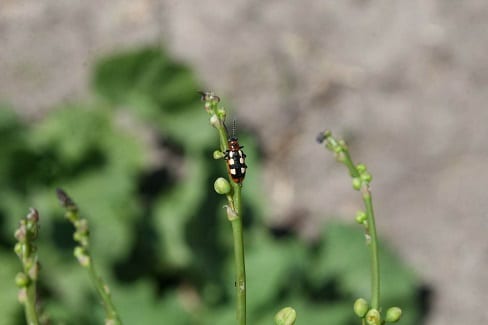–by Dr. Raymond Cloyd
If you are growing asparagus then it is that time of year to be aware of the only insect pest of asparagus; the common asparagus beetle, Crioceris asparagi. Adult beetles are 1/4 inch long. The body is metallic blue to black with red margins and six cream-colored markings (Figure 1).
Figure1. Common Asparagus Beetle Adult (Author–Raymond Cloyd, KSU)
Adults emerge from the soil in early spring and fly to new asparagus shoots where they mate and feed. Females lay up to 30 eggs on the end of spear tips as they emerge from the soil (Figure 2)
Figure2. Common Asparagus Beetle Eggs on Spear Tip of Asparagus (Author–Raymond Cloyd, KSU)
Larvae hatch from eggs after about a week, migrate onto the ferns, and commence feeding. The larvae look like a small slug. They are wrinkled, 1/3 inch in length, and olive-green to gray with black heads and legs (Figure 3).
Figure3. Common Asparagus Beetle Larvae Feeding on Asparagus (Author–Raymond Cloyd, KSU)
Larvae feed for approximately two-weeks and then drop to the ground, burrow into the soil, and form a yellow pupa. After several weeks, adults emerge and start feeding. Common asparagus beetles overwinter underneath plant debris, loose bark, or hollow stems of old asparagus plants. The life cycle can be completed in eight-weeks. There are two generations in Kansas.
The adults and larvae feed on asparagus spears and can defoliate ferns if populations are extensive. Larvae consume leaves and tender buds near the tips, which leaves scars that eventually turn brown. Damage caused by larvae interferes with the plant’s ability to photosynthesize (manufacture food); thus depleting food reserves for next year’s crop.
The plant protection strategies that can be implemented to reduce problems with common asparagus beetle populations include: applying insecticides; hand-picking eggs, adults, and larvae and placing into a container with soapy water; and/or removing any plant debris after the growing season to eliminate overwintering sites for adults. Insecticides should be applied as soon as common asparagus beetles are present, and again in late summer through early fall to kill adults before they overwinter. Thorough coverage of all plant parts is important in suppressing populations.


